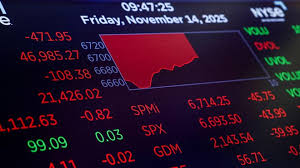The upcoming Thanksgiving holiday in the United States will see the closure of the stock markets on Thursday, Nov. 27, with an early closing time on Friday, Nov. 28. Both the Nasdaq and New York Stock Exchange will be closed on Thanksgiving and will open on the 28th, but will close early at 1 p.m. ET. The U.S. bond market will also be closed on Thursday and is set to close at 2 p.m. ET on Friday, Nov. 28, according to the Securities Industry and Financial Markets Association.
Following the Thanksgiving break and the early closure on Black Friday, Wall Street will resume normal operations until late December. The next market closure is scheduled for Thursday, Dec. 25, in observance of Christmas, with early closures also planned for Christmas Eve.
Thanksgiving week has historically been a strong period for the markets, often marked by positive sentiment among investors. Recent market performance leading up to the holiday saw the S&P 500, Dow Jones Industrial Average, and Nasdaq Composite registering gains for the fourth consecutive day. Stocks like Oracle experienced a boost, with shares climbing approximately 4% after an endorsement from Deutsche Bank, citing the stock's attractiveness for investors considering Oracle's overall business outlook. This positive movement also influenced related technology and AI stocks such as Nvidia and Microsoft.
Looking ahead, market watchers are anticipating the Federal Reserve's potential interest rate cut in December, with futures markets indicating an 85% chance of a quarter-point reduction. Such expectations, if not met, could lead to market volatility. However, experts believe that a significant disappointment is unlikely. The possibility of Kevin Hassett becoming the Fed chair in the future could lead to even lower interest rates, according to Bank of America economist Aditya Bhave.
The prospect of looser monetary policy often bodes well for stocks, with some analysts projecting optimistic year-end targets for the S&P 500, such as 7,400 by CFRA Chief Investment Strategist Sam Stovall and potentially as high as 8,000 by JPMorgan. Investors have reason to be thankful for the positive market performance in 2025 and are eyeing potential opportunities in the coming year.
In market updates, U.S. stocks recorded gains for the fourth consecutive day, driven by technology giants like Oracle and Nvidia. The positive momentum extended to Asia-Pacific markets, with India's Nifty 50 and BSE Sensex hitting record highs. Apple is expected to surpass Samsung in smartphone shipments this year, marking the first time in 14 years that Apple will outsell its rival.
On a different note, China's industrial profits suffered a decline in October, dropping by 5.5% year-on-year, reflecting the impact of trade tensions with the U.S. Additionally, a new study from MIT suggests that AI technologies could potentially replace 11.7% of the U.S. workforce, amounting to $1.2 trillion in wages across various sectors.
Notably, Bitcoin is facing headwinds, with a decline of over 20% in November. Analysts predict further declines for the cryptocurrency by the end of the year. However, foreign investors are showing interest in China's AI sector, attracted by comparatively lower valuations amidst concerns of a potential tech bubble in the U.S.
In terms of venture capital investments, the U.S. continues to dominate the AI and robotics sector, with deals exceeding $160 billion in 2025. However, China's AI investment landscape, although smaller in scale at just over $10 billion, is showing promise due to regulatory dynamics and a resilient startup ecosystem.
The intersection of regulatory factors in China, U.S. export controls, and a competitive local startup environment has drawn global investor attention to the evolving AI landscape. The market dynamics are shaping the future of AI investments and technological advancements on a global scale.
This article provides a comprehensive look at the recent developments in the financial markets, technology sector, and AI landscape, offering insights into the trends shaping investment opportunities and market dynamics in 2025 and beyond.

